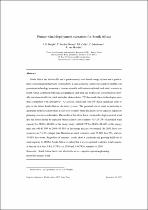JavaScript is disabled for your browser. Some features of this site may not work without it.
- ResearchSpace
- →
- Research Publications/Outputs
- →
- Conference Publications
- →
- View Item
| dc.contributor.author |
Wright, Jarrad G

|
|
| dc.contributor.author |
Bischof-Niemz, Sebastian T

|
|
| dc.contributor.author |
Calitz, Joanne R

|
|
| dc.contributor.author |
Mushwana, Crescent

|
|
| dc.date.accessioned | 2018-03-02T10:08:34Z | |
| dc.date.available | 2018-03-02T10:08:34Z | |
| dc.date.issued | 2017-11 | |
| dc.identifier.citation | Wright, J.G. et al. 2017. Future wind deployment scenarios for South Africa. WindAc, Cape Town, 14-16 November 2017 | en_US |
| dc.identifier.uri | http://windac-africa.com/wp-content/uploads/2017/09/Abstract_Jarrad-Wright.pdf | |
| dc.identifier.uri | http://hdl.handle.net/10204/10070 | |
| dc.description | Paper presented at WindAc, Cape Town, 14-16 November 2017 | en_US |
| dc.description.abstract | South Africa has historically had a predominantly coal based energy system and a particularly coal dominated electricity system due to a large domestic coal resource and favourable coal generation technology economics. A more recently well understood wind (and solar) resource in South Africa combined with large geographical land-area and technology cost reductions globally and domestically for wind and solar photovoltaics (PV) has made these technologies more than competitive with alternatives. As a result, wind (and solar PV) have significant roles to play in the future South African electricity system. The potential role of wind in particular is quantified in this research where a least-cost scenario-based electricity sector capacity expansion planning exercise is undertaken. The results of this show that a considerable deployment of wind into the future should be expected where in least-cost scenarios ˜15-25 GW of installed wind capacity by 2030 (˜10-20% of the energy mix), ˜40-60 GW by 2040 (˜20-40% of the energy mix) and ˜60-85 GW by 2050 (45-50% of the energy mix) is cost-optimal. By 2050, least-cost scenarios are 5-12% cheaper than Business-as-usual scenarios, emit 55-60% less CO2 and use 55-60% less water. Regardless of scenario, results show a consistent and growing build-out of wind capacity to 2050 in South Africa revealing that it is cost-optimal to deploy wind capacity at the rate of at least 0.8-1.0 GW/yr to 2030 and 3-4 GW/yr therafter to 2050. | en_US |
| dc.language.iso | en | en_US |
| dc.relation.ispartofseries | Worklist;19823 | |
| dc.subject | Least-cost | en_US |
| dc.subject | Electricity sector | en_US |
| dc.subject | Capacity expansion planning | en_US |
| dc.subject | Renewable energy | en_US |
| dc.subject | Wind | en_US |
| dc.title | Future wind deployment scenarios for South Africa | en_US |
| dc.type | Conference Presentation | en_US |
| dc.identifier.apacitation | Wright, J. G., Bischof-Niemz, S. T., Calitz, J. R., & Mushwana, C. (2017). Future wind deployment scenarios for South Africa. http://hdl.handle.net/10204/10070 | en_ZA |
| dc.identifier.chicagocitation | Wright, Jarrad G, Sebastian T Bischof-Niemz, Joanne R Calitz, and Crescent Mushwana. "Future wind deployment scenarios for South Africa." (2017): http://hdl.handle.net/10204/10070 | en_ZA |
| dc.identifier.vancouvercitation | Wright JG, Bischof-Niemz ST, Calitz JR, Mushwana C, Future wind deployment scenarios for South Africa; 2017. http://hdl.handle.net/10204/10070 . | en_ZA |
| dc.identifier.ris | TY - Conference Presentation AU - Wright, Jarrad G AU - Bischof-Niemz, Sebastian T AU - Calitz, Joanne R AU - Mushwana, Crescent AB - South Africa has historically had a predominantly coal based energy system and a particularly coal dominated electricity system due to a large domestic coal resource and favourable coal generation technology economics. A more recently well understood wind (and solar) resource in South Africa combined with large geographical land-area and technology cost reductions globally and domestically for wind and solar photovoltaics (PV) has made these technologies more than competitive with alternatives. As a result, wind (and solar PV) have significant roles to play in the future South African electricity system. The potential role of wind in particular is quantified in this research where a least-cost scenario-based electricity sector capacity expansion planning exercise is undertaken. The results of this show that a considerable deployment of wind into the future should be expected where in least-cost scenarios ˜15-25 GW of installed wind capacity by 2030 (˜10-20% of the energy mix), ˜40-60 GW by 2040 (˜20-40% of the energy mix) and ˜60-85 GW by 2050 (45-50% of the energy mix) is cost-optimal. By 2050, least-cost scenarios are 5-12% cheaper than Business-as-usual scenarios, emit 55-60% less CO2 and use 55-60% less water. Regardless of scenario, results show a consistent and growing build-out of wind capacity to 2050 in South Africa revealing that it is cost-optimal to deploy wind capacity at the rate of at least 0.8-1.0 GW/yr to 2030 and 3-4 GW/yr therafter to 2050. DA - 2017-11 DB - ResearchSpace DP - CSIR KW - Least-cost KW - Electricity sector KW - Capacity expansion planning KW - Renewable energy KW - Wind LK - https://researchspace.csir.co.za PY - 2017 T1 - Future wind deployment scenarios for South Africa TI - Future wind deployment scenarios for South Africa UR - http://hdl.handle.net/10204/10070 ER - | en_ZA |






